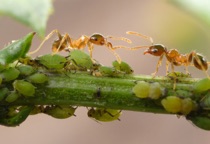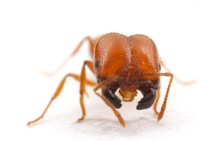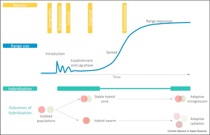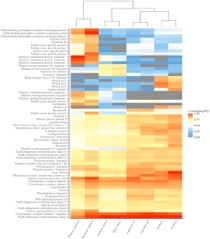
e-mail: Denis.Fournier@ulb.be
Denis Fournier on ResearchGate
Follow @denisfournierdf on Twitter
Research interests

Sex and clonality in ants and termites
Sexual reproduction is costly for females, as they potentially transmit only half as many genes per offspring compared to asexual females, a phenomenon known as the "two-fold cost of sex." However, asexual lineages face several disadvantages, such as the accumulation of deleterious mutations and reduced genetic diversity in the short term, as well as potential evolutionary challenges in the long term. In some species of social insects, reproductive females use both sexual and asexual reproduction to produce reproductive and non-reproductive females. We are interested in exploring the reasons behind and mechanisms of this unusual strategy.
The evolution of life-history traits in social insects
Our research investigates how various factors of the breeding system, such as the number of breeders and their genetic relationships, impact colony genetic structure, reproductive conflicts, dispersal strategies, levels of inter-nest aggression, and task preferences.
Biological invasions
Biological invasions have significant ecological and economic impacts, particularly through the disruption of trophic cascades and the homogenization of biodiversity. Our research focuses on studying biological invasions in social insects using a combinatory approach that integrates genetic, behavioral, chemical, and ecological data.
more...
Selected publications

Duquesne E, Fournier D (2025) Climate change redefines sea turtle hotspots: vessel strike risks and gaps in protected area. Science Advances 11, eadw4495.
doi: 10.1126/sciadv.adw4495
Duquesne E, Fournier D (2025) Urban and agricultural areas under threat of the termite pest genus Heterotermes: insights from species distribution modelling and phylogeny. Journal of Pest Science, 98, 1357-1378.
doi: 10.1007/s10340-025-01866-6
Duquesne E, Fournier D (2024) Connectivity and climate change drive the global distribution of highly invasive termites. Neobiota 92, 281-314.
doi: 10.3897/neobiota.92.115411
Araujo N, Hellemans S, Roisin Y, Fournier D (2023) Transcriptomic profiling of castes and of sexually and parthenogenetically produced reproductive females in the termite Cavitermes tuberosus. Entomologia Experimentalis et Applicata 171, 350-360.
doi: 10.1111/eea.13285
Steenacker M, Tanabe LK, Rusli MU, Fournier D (2023) The influence of incubation duration and clutch relocation on hatchling morphology and locomotor performances of green turtle (Chelonia mydas). Journal of Experimental Marine Biology and Ecology 569, 151954.
doi: 10.1016/j.jembe.2023.151954
Fournier D, Aron S (2021) Hybridization and invasiveness in social insects – The good, the bad and the hybrid. Current Opinion in Insect Science 46, 1-9.
doi: 10.1016/j.cois.2020.12.004
Hellemans S, Kaczmarek N, Marynowska M, Calusinska M, Roisin Y, Fournier D (2019) Bacteriome-associated Wolbachia of the parthenogenetic termite Cavitermes tuberosus. FEMS Microbiology Ecology 95, fiy235.
doi: 10.1093/femsec/fiy235
Wauters N, Dekoninck W, Fournier D (2018) Introduction history and genetic diversity of the invasive ant Solenopsis geminata in the Galápagos Islands. Biological Invasions 20, 3207-3226.
doi: 10.1007/s10530-018-1769-1
Aron S, Lybaert P, Baudoux C, Vandervelden M, Fournier D (2016) Sperm production characteristics vary with level of sperm competition in Cataglyphis desert ants. Functional Ecology 30, 614-624.
doi: 10.1111/1365-2435.12533
Fournier D, de Biseau J-C, De Laet S, et al. (2016) Social structure and genetic distance mediate nestmate recognition and aggressiveness in the facultative polygynous ant Pheidole pallidula. PLoS ONE 11, e0156440.
doi: 10.1371/journal.pone.0156440
Fournier D, Hellemans S, Hanus R, Roisin Y (2016) Facultative asexual reproduction and genetic diversity of populations in the humivorous termite Cavitermes tuberosus.
Proceedings of the Royal Society B: Biological Sciences 283, 2016.0196.
doi: 10.1098/rspb.2016.0196
Foucaud J, Orivel J, Fournier D, et al. (2009) Reproductive system, social organization, human disturbance and ecological dominance in native populations of the little fire ant, Wasmannia auropunctata. Molecular Ecology 18, 5059-5073.
doi: 10.1111/j.1365-294X.2009.04440.x
Fournier D, Aron S (2009) No-male’s land for an Amazonian ant. Current Biology 19, R738-R740.
doi: 10.1016/j.cub.2009.07.021
Foucaud J, Fournier D, Orivel J, et al. (2007) Sex and clonality in the little fire ant. Molecular Biology and Evolution 24, 2465-2473.
doi: 10.1093/molbev/msm180
Fournier D, Estoup A, Orivel J, et al. (2005) Clonal reproduction by males and females in the little fire ant. Nature 435, 1230-1234.
doi: 10.1038/nature03705
Fournier D, Keller L, Passera L, Aron S (2003) Colony sex ratios vary with breeding system but not relatedness asymmetry in the facultatively polygynous ant Pheidole pallidula. Evolution 57, 1336-1342.
doi: 10.1111/j.0014-3820.2003.tb00341.x
Team

PhD students
Emilio CAITI
phone: +32 (0)2 650 45 25 e-mail: Emilio.Caiti@ulb.be
-
An insect pest flies over the English Channel and settles in Great Britain: study of dispersal mechanisms and reproductive strategies in Ips typographus (Coleoptera, Curculionidae, Scolytinae)
phone: +32 (0)2 650 22 67 e-mail: Edouard.Duquesne@ulb.be
-
Effects of urbanization on termite assemblages, population genetic structure and colony breeding systems - The case of the invasive termite Heterotermes tenuis
Nicolas FONTAINE
phone: +32 (0)2 650 49 58 e-mail: Nicolas.Fontaine@ulb.be
-
Distribution, diversity and genetic analyses of the termite species of the Termes genus
Marion STEENACKER
phone: +32 (0)2 650 22 67 e-mail: Marion.Steenacker@ulb.be
-
Linking nesting ecology and genetics with hatchling morphology and fitness for the conservation of green turtles (Chelonia mydas)
MSc students
Emilie GHEYLE
-
Impact de l'urbanisation et de l'étalement urbain sur la diversité génétique chez un termite envahissant
Alexia LACOMBE
-
Etude de la valeur des «zones de nature spontanée» dans la conservation des abeilles sauvages en milieu urbain
Iona PAQUES
-
Les conséquences des activités humaines et du réchauffement climatique sur les habitats de reproduction des tortues marines
Chloë VAN LEYNSEELE
-
Caractérisation des impacts anthropiques sur les pontes de tortues marines en Martinique
Previous MSc and PhD students
Sophie DE LAET
-
Genetic diversity, intraspecific chemical variations and nestmate recognition in the ant Pheidole pallidula
Marine DELFERRIERE
-
Social insects and biological invasions
Nancy DEVAUX
-
Reversion to monogyny in cooperative foundations of the ant Lasius niger - Effects of queen phenotype and social environment
Audrey HARVENGT
-
Diversité génétique et routes d’introduction d’Ips typographus en Europe
Simon HELLEMANS
-
Evolutionary origin of sexuals and sex-ratio in the termite Cavitermes tuberosus
Simon HELLEMANS
-
Modalities of Asexual Queen Succession in the neotropical humivorous termite Cavitermes tuberosus and implications of reproductive organisation on alate sex ratio
Nicolas KACZMAREK
-
From modalities of reproductive strategies in the termite’s group Subulitermes to the origins and evolution of Asexual Queen Succession in Termitidae
Nicolas KACZMAREK
-
The impact of endosymbionts on the reproductive system and sex-ratio of the tropical humivorous termite Cavitermes tuberosus
María Luisa Martín Cerezo
-
Predicting the invasion risk by the tropical fire ant Solenopsis geminata across the Galápagos Archipelago
Romain MOERMAN
-
Multifactorial analyses of bumblebees decline
Marion STEENACKER
-
The scute pattern variabilities in the green sea turtles (Chelonia mydas) at Chagar Hutang sanctuary, Redang Island, Malaysia
Quentin STRUELENS
-
Invasive ant species and global warming - risk prediction using geospatial models
Vanessa VAN BOSSCHE
-
Population genetics, chemical recognition and aggressive behaviours of the invasive ant Pheidole megacephala in its native range
Antonin VITAL
-
Population genetics and reproductive strategies of two termite species of the genus Microcerotermes
Nina WAUTERS
-
Impact of the invasive ant Solenopsis geminata on the endemic fauna of the Galápagos islands - Genetic and ecological context
Teaching

Bachelier en Sciences biologiques BA-BIOL
. BIOL-F-314 Recherche et communication scientifique
Master en Biologie des organismes et écologie MA-BIOR
. BIOL-F-450 Evolution et écologie - comprendre la diversité phénotypique et génétique
. STAG-F-034 Professional Internship
ERASMUS Academic coordinator «INcoming students» (Department «Biology of Organisms»)
. For information concerning intermational exchange programs look at this ULB site
. Erasmus program and details for INcoming (foreign) students (Department «Biology of Organisms»)























